Israël : visite guidée de la nouvelle vallée de l’énergie solaire du désert du Néguev

[:fr]L’un des plus grands projets d’énergie renouvelable au monde, le complexe tentaculaire du Néguev au sud d’Israël produira 300 mégawatts d’électricité propre tous les jours. Quatre Tours Eiffel pourraient être construites avec les 28 000 tonnes d’acier utilisées par Negev Energy pour construire la centrale thermo-solaire Ashalim dans le désert du Néguev. S’étendant sur 988 hectares de sable, c’est un spectacle impressionnant que les touristes pourront découvrir depuis une plate-forme après l’ouverture de l’usine l’été prochain.
Le projet Negev Energy est l’une des deux gigantesques centrales thermo-solaires qui se trouvent côte à côte à Ashalim, à environ 40 km au sud de Beer Sheva. L’autre projet comporte une grande tour. En plus de ces deux usines produisant de l’électricité à partir de la chaleur du soleil en utilisant différentes technologies, deux autres usines produiront un total de 70 mégawatts d’électricité en utilisant des panneaux photovoltaïques. La combinaison des technologies en un seul endroit est sans précédent dans le monde.
Au total, le complexe d’Ashalim fournira environ 300 mégawatts d’électricité par jour au réseau national de l’Israel Electric Company, contribuant à hauteur de 2,5% de l’objectif du gouvernement d’atteindre 10% d’énergie renouvelable d’ici 2020. Actuellement, seulement 2,6% de l’électricité israélienne est produite à partir de sources renouvelables.
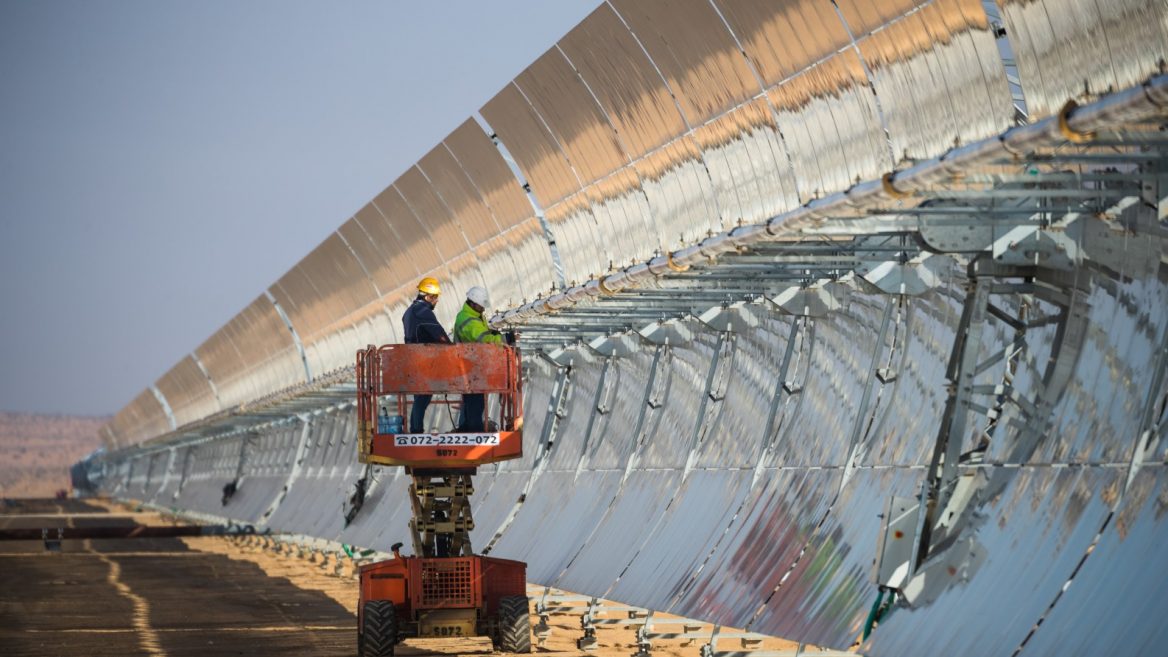
Chacun des quatre projets Ashalim est financé par des consortiums internationaux basés sur le modèle BOT (build-operate-transfer). Après la construction et 25 ans de fonctionnement, ils seront transférés à l’Etat.
Le projet de Negev Energy de 1,1 milliard de dollars est le plus important projet énergétique d’Israël et l’un des plus grands projets d’énergie renouvelable au monde.
Negev Energy est filiale à 50% du groupe israélien Shikun & Binuï.
Les 16 224 miroirs paraboliques de 121 mégawatts de l’usine de 121 mégawatts, équipés d’un demi-million de miroirs (nettoyés deux fois par semaine), capteront la chaleur du soleil et l’achemineront sur 203 kilomètres de tuyaux en acier à isolation en verre.
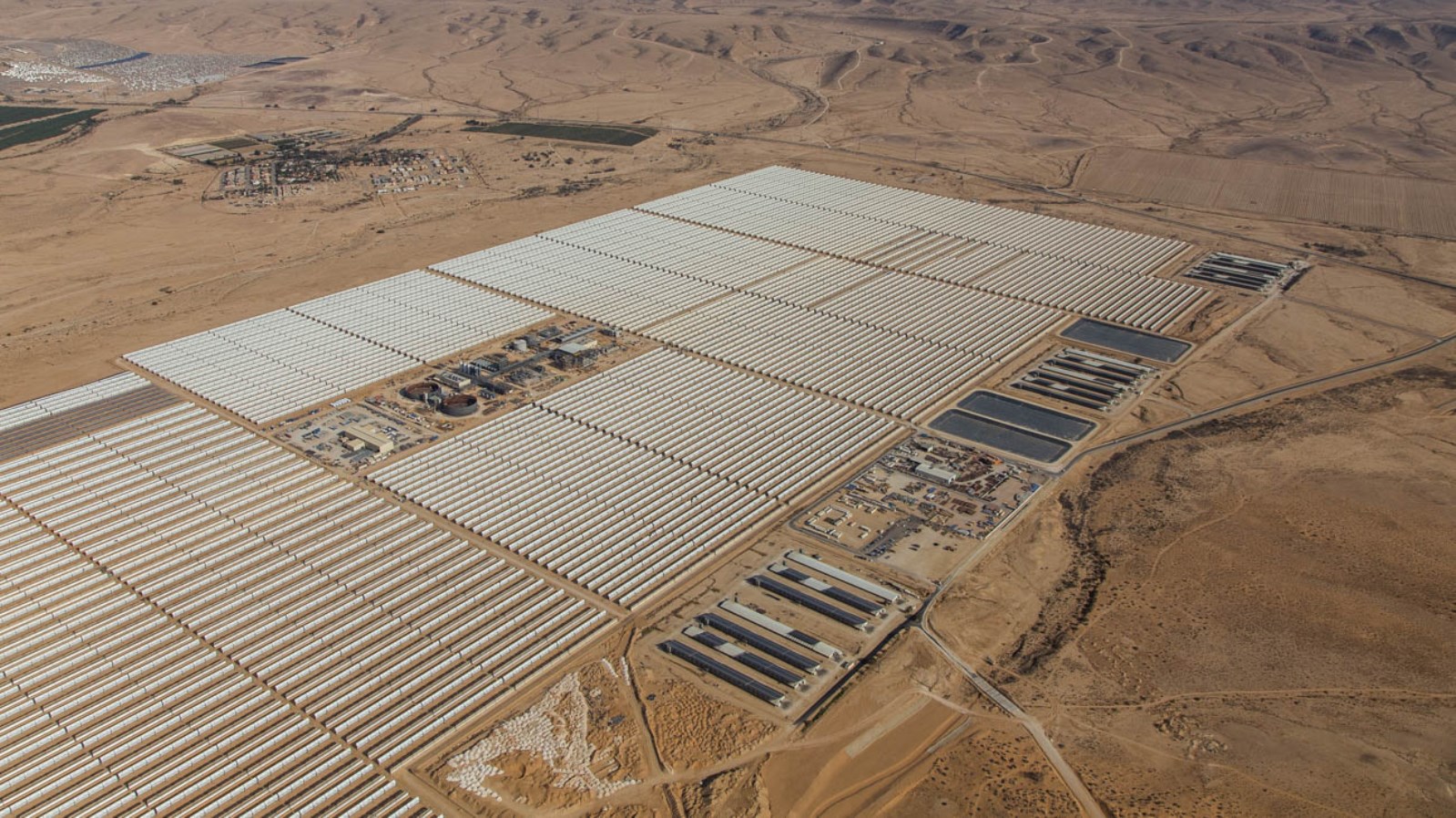
Le rayonnement va chauffer l’huile thermique qui coule à travers les tuyaux à 390 degrés Celsius. L’huile chaude transformera alors l’eau en vapeur pour entraîner une turbine générant suffisamment d’énergie pour 60 000 foyers. Cela équivaudra à retirer 50 000 véhicules de la route, évitant ainsi les émissions de quelque 245 000 tonnes de dioxyde de carbone.
L’usine fonctionnera jusqu’à 18 heures par jour, même par temps nuageux et après la tombée de la nuit, en utilisant un système d’échange de chaleur et de stockage de sel fondu pour garder l’huile chaude. Du gaz naturel sera également utilisé. Didi Paz, PDG de Negev Energy, sougligne : « c’est la première fois que cette technologie est utilisée en Israël. »
L’usine utilise une combinaison d’innovations israéliennes et étrangères testées sur le terrain. Par exemple, les miroirs sont importés d’Espagne, le pétrole des États-Unis et les tuyaux isolés sont fabriqués par une entreprise à Beit Shemesh.
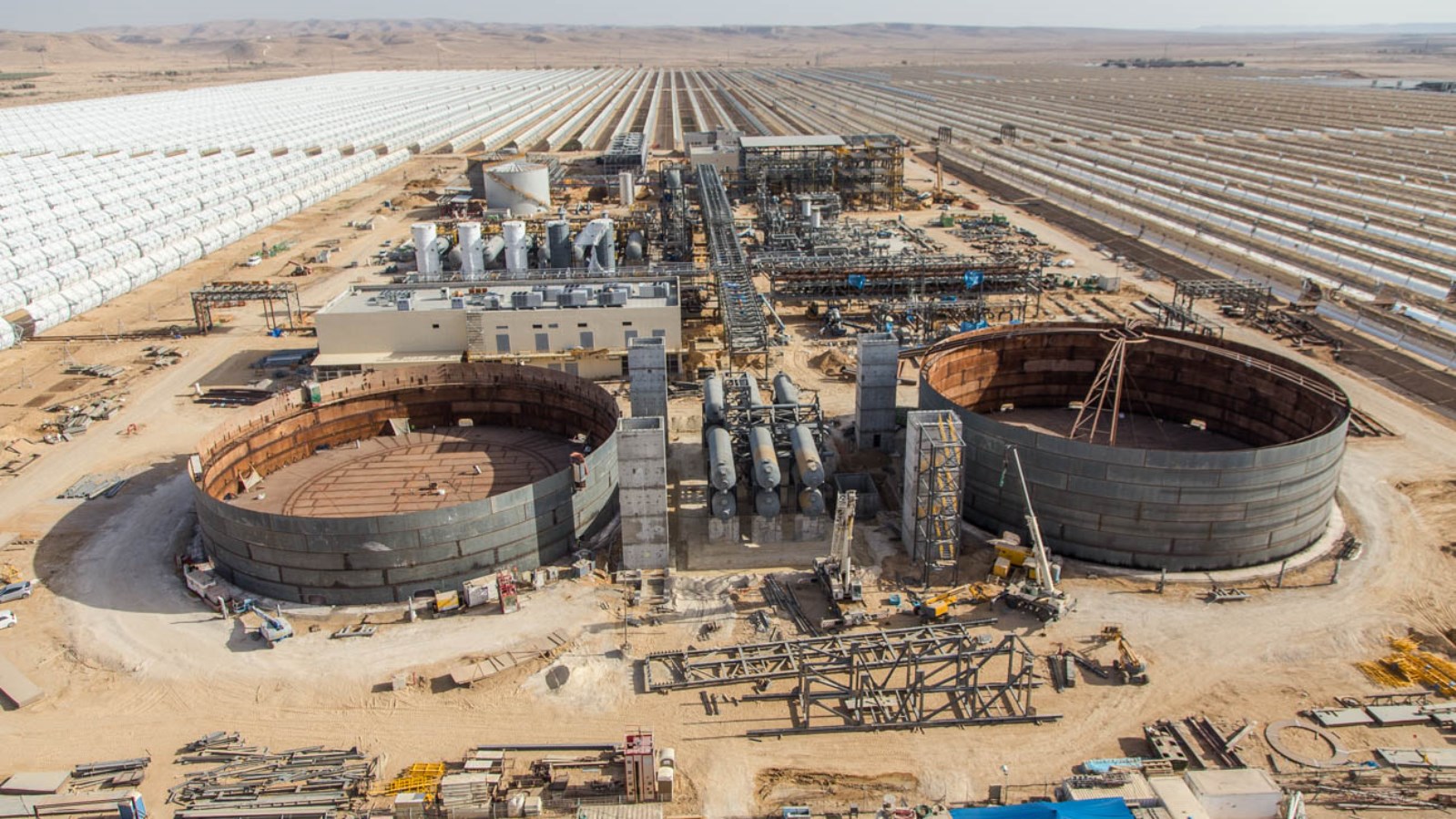
« Israël a été l’un des pionniers dans le développement scientifique de la technologie thermo-solaire, en particulier à l’Institut Weizmann il y a 30 ou 40 ans. Mais Israël a pris du retard dans l’application de la technologie », a déclaré Didi Paz à ISRAEL21c.
L’autre installation de Negev Energy est une station thermo-solaire de 110 watts composée de 50000 miroirs hélio-statiques pilotés par ordinateur qui concentrent la chaleur du soleil sur une chaudière au sommet d’une tour de 250 mètres.
Ce projet BOT est en cours de construction par Megalim Solar Power pour un consortium composé de BrightSource Energy, de GE Renewable Energy et du Noy Fund.
Les deux énormes installations thermo-solaires surplombent les 100 maisons du village d’Ashalim, fondé il y a une quinzaine d’années par l’Association Ayalim, un mouvement étudiant local pour peupler le Néguev et la Galilée.
«Ces familles se sont réveillées un jour et ont compris que quatre monstres vont les entourer», a déclaré Didi Paz, expliquant que le gouvernement a choisi ce site pour diverses raisons. «Nous voulons leur faciliter la vie, nous les avons donc constamment engagés, nous les avons tenus au courant du projet et nous avons essayé de ne pas nuire à leur style de vie. Maintenant, ils vendent des services au projet et nous avons été en mesure de leur fournir une meilleure infrastructure qui aide leur agriculture et leurs maisons. Au début il y a trois ou quatre ans nous étions ennemis et nous sommes devenus amis. »
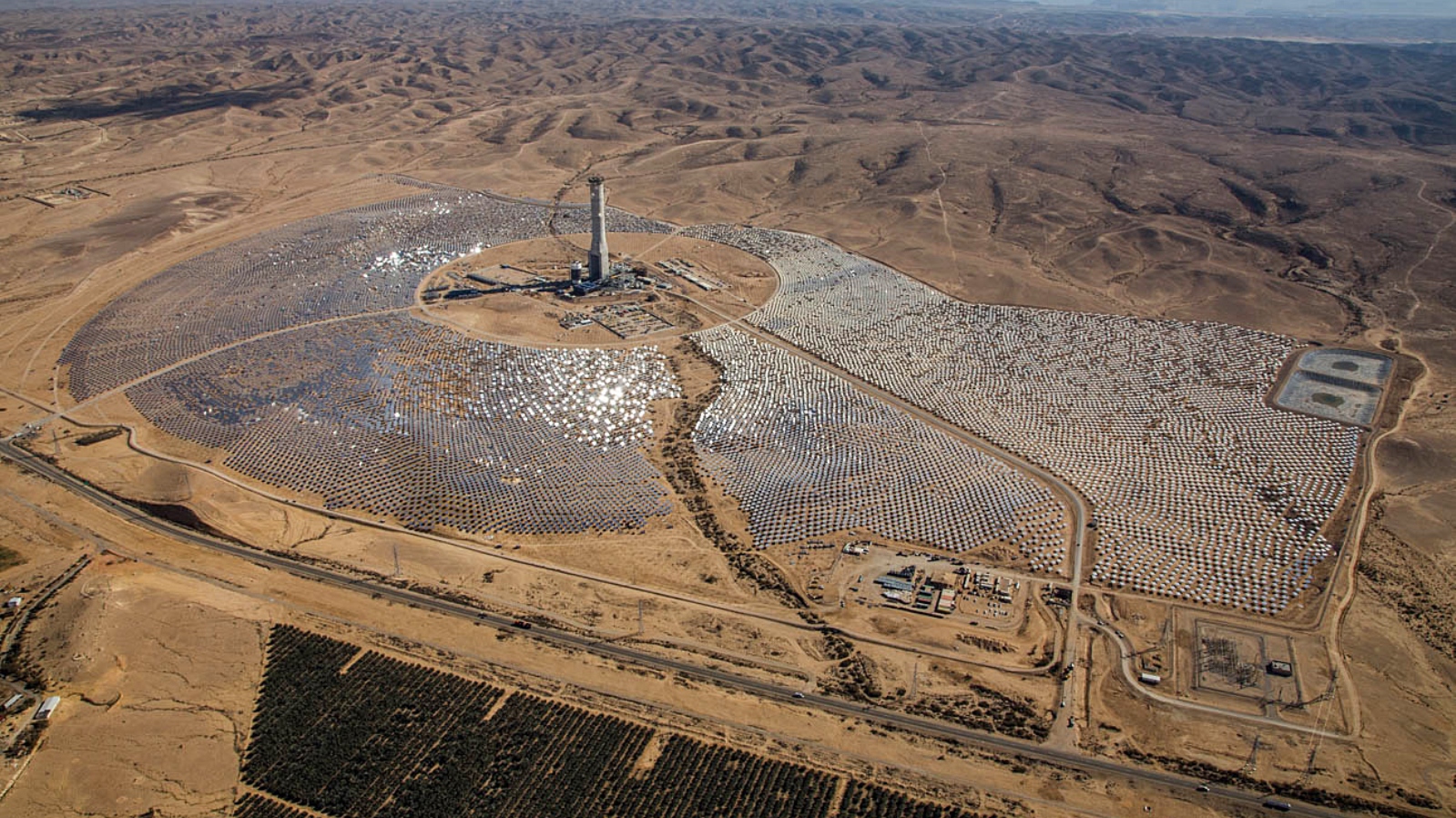
Yuval Saragusty, responsable de l’énergie, de la santé, de la sûreté et de la sécurité chez Negev Energy, supervise le développement durable sur site. Son équipe a effectué des transferts de petits animaux, déplacé des plantes rares du désert et restauré des camions de terre végétale enlevés dans la construction. Afin de ne pas déranger les animaux actifs après la tombée de la nuit, le site ne sera pas illuminé la nuit.
« Il est impossible d’éviter la consommation intensive de ressources naturelles pour toute centrale électrique, même si elle produit une énergie propre et verte. Mais le projet Ashalim répond aux normes environnementales internationales avancées », a déclaré Didi Paz.
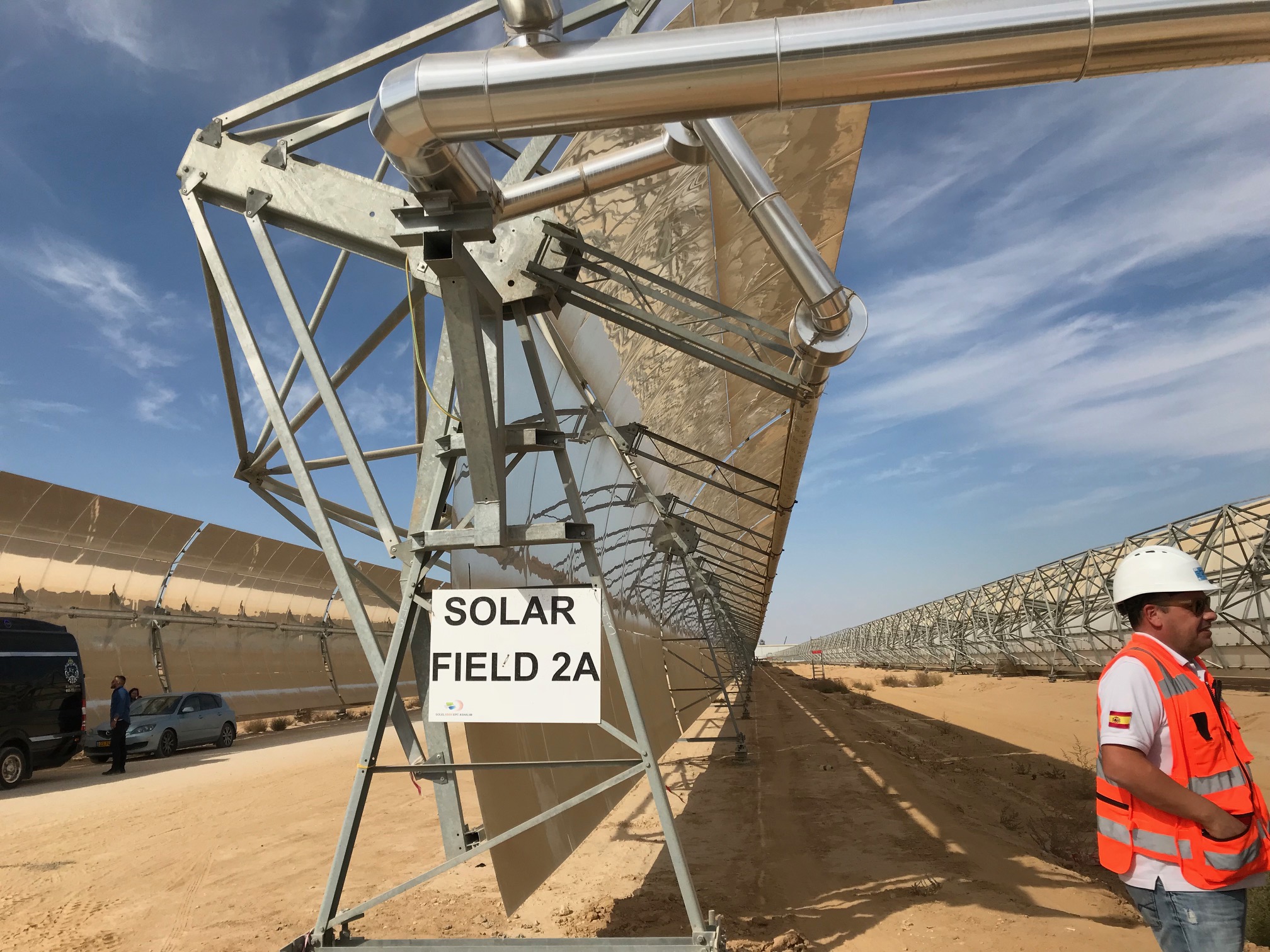
L’huile thermique sera entièrement recyclée, tandis que l’eau (1,6 million de mètres cubes par an, provenant principalement des usines de dessalement) sera recyclée autant que possible. L’eau qui est devenue trop salée en raison du recyclage et de l’évaporation répétés sera rejetée dans deux bassins d’évaporation plutôt que dans les deux cours d’eau qui bordent la centrale.
Environ 300 des plus de 1000 employés qui ont participé à la construction viennent du village bédouin voisin de Bir Hadaj. Tous les écoliers de Bir Hadaj ont visité le site et ont appris comment la technologie fonctionne. « Ce projet est également socio-responsable. Nous donnons la préférence aux résidents du Sud. Plus de la moitié de nos employés sont maintenant des résidents du Néguev. Nous faisons tout notre possible pour les faire bénéficier du projet en les formant et en les employant », conclut Didi Paz.
Environ 60 employés assureront la maintenance de l’usine durant les 25 années de l’exploitation privée.
Traduction/adaptation Esther Amar pour Israël Science Info
Source : Israel21C
https://www.youtube.com/watch?v=UgExSBjQ8Jg
[:en]
Four Eiffel Towers could be built with the 28,000 tons of steel being used by Negev Energy to construct the Ashalim Thermo-Solar Power Station in Israel’s Negev Desert. Spread flat over 988 acres of sand, the array is nevertheless an impressive sight that tourists will be able to view from a platform after the plant opens next summer.
The Negev Energy project – which ISRAEL21c toured recently — is one of two gigantic thermo-solar plants going up side by side in Ashalim, about 40 kilometers south of Beersheva. The other one actually does incorporate a tall tower.

In addition to these two plants generating electricity from the sun’s heat using different technologies, two other plants will produce a total of 70 megawatts of electricity from sunlight using photovoltaic panels. The combination of technologies in one spot is unprecedented in the world.
Altogether, the Ashalim complex will provide approximately 300 megawatts of electricity daily to the Israel Electric Company’s national grid, contributing 2.5 percent toward the government’s goal of 10% renewable energy by 2020. Currently, only 2.6% of Israel’s electricity is generated from renewable sources.

“I think that Ben-Gurion is turning over in his grave, but from joy,” comments Eran Doron, head of the Ramat Hanegev Regional Council in whose jurisdiction Ashalim lies.
Doron is referring to a 1955 speech by first Israeli Prime Minister David Ben-Gurion, spelling out his vision for scientific innovation arising from the Israeli desert. Large-scale water desalination and solar-energy generation were central to his dream and both are happening.
Half a million mirrors
Each of the four Ashalim projects is funded by international consortiums based on the build-operate-transfer (BOT) model. Following construction and 25 years of operation, they’ll be transferred to the state.
Our tour focused on Negev Energy’s $1.1 billion project, said to be the largest energy project in Israel and one of the largest renewable energy projects in the world.
Negev Energy is a 50% subsidiary of Israel’s global Shikun & Binui Group; the other owners include the Noy Fund and Spanish company TSK.
The 121-megawatt plant’s 16,224 parabolic troughs, fitted with half a million mirrors (cleaned twice weekly), will collect the sun’s heat from any angle and transfer it through 203 kilometers of glass-insulated steel pipes that absorb the radiation.
The radiation will heat thermal oil flowing through the pipes to 390 degrees Celsius. The hot oil will then turn water into steam to drive a turbine generating enough power for 60,000 homes.
The net effect will be equivalent to taking 50,000 vehicles off the road, preventing emissions of some 245,000 tons of carbon dioxide.

The plant will operate up to 18 hours per day, even in cloudy weather and after dark, using a molten salt heat-exchange and storage system to keep the oil hot. Some natural gas will be used as well.
“This is a game-changer,” said Negev Energy CEO Didi Paz. “It’s the first time this proven technology is being used in Israel.”
The plant uses a combination of field-tested Israeli and foreign innovations. For example, the mirrors are imported from Spain, the oil from the United States and the insulated pipes are made by a company in Beit Shemesh.
“Israel was one of the pioneers in developing the science behind thermo-solar technology, especially at the Weizmann Institute 30 or 40 years ago. But Israel lagged behind in applying the technology,” Paz told ISRAEL21c.
Tower of Power
The companion to the Negev Energy installation is a 110-watt thermo-solar station consisting of 50,000 computer-controlled heliostat mirrors that concentrate the sun’s heat onto a boiler atop a 250-meter tower.
This BOT project is being built by Megalim Solar Power for a consortium consisting of BrightSource Energy, GE Renewable Energy and the Noy Fund.

The two massive thermo-solar installations overshadow the 100 houses of Ashalim village, founded about 15 years ago by the Ayalim Association, a grassroots student movement to populate the Negev and Galilee.
“These families woke up one day and realized four monsters are going to be surrounding them,” said Paz, explaining that the government chose this particular site for a variety of reasons.
“We want to make life easier for them so we’ve engaged them on a constant basis, keeping them updated on the project and trying to avoid harming their peace. Now they sell services to the project and we’ve been able to provide them with better infrastructure that helps their agriculture and homes. We started three or four years ago as enemies and we’ve become friends.”
What about wildlife?
Yuval Saragusty, Negev Energy’s manager of energy, health, safety and security, oversees sustainability on site. His crew made 26 small-animal crossings, relocated rare desert plants and will restore truckloads of topsoil removed in construction. So as not to disturb animals active after dark, the plant won’t have perimeter lights.
Although there’s no avoiding the intensive natural-resource consumption of any power plant – even one producing clean, green energy — the Ashalim project meets advanced international environmental standards, said Paz.
The thermal oil will be fully recycled, while the water (1.6 million cubic meters annually, mainly from desalination plants) will be recycled as much as possible. Water that has gotten too salty from repeated recycling and evaporation will be released into two evaporation ponds rather than into the two streams bordering the plant.

The project also strives for social responsibility, Paz noted.
About 300 of the more than 1,000 employees in the construction phase come from the neighboring Bedouin village of Bir Hadaj. All the schoolchildren of Bir Hadaj have toured the site and learned how the technology works.
“We are giving preference to residents of the South. More than half of our employees now are residents of the Negev,” Paz said. “We are doing everything possible to make them benefit from the project by training and employing them.”
About 60 workers will operate and maintain the plant during its 25 years of private operation.
for Israel21C[:]







